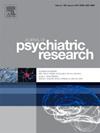Posttraumatic anger in a national Sample: Demographic and clinical correlates
IF 3.7
2区 医学
Q1 PSYCHIATRY
引用次数: 0
Abstract
Posttraumatic stress disorder (PTSD) is often characterized by intense anger and other negative emotions. This led to the inclusion of the experience of these negative emotions among DSM-5 PTSD diagnostic criteria. Though anger has been linked to a range of different conditions, the concept of posttraumatic anger has not been studied extensively. The present study investigated sociodemographic and psychiatric correlates of posttraumatic anger in a nationally representative sample of individuals exposed to trauma (N = 23,936). Notably, 22.4 % of the sample endorsed posttraumatic anger, and of those that met criteria for PTSD (n = 2339), 80.6 % endorsed posttraumatic anger. We found that female sex, Native American/Alaskan race, and identifying as a sexual minority were associated with increased odds of endorsing posttraumatic anger. Conversely, Asian race, being married, having higher income and education, and being older were associated with lower likelihood of posttraumatic anger. We also found multiple anxiety, mood, and substance used disorders were associated with posttraumatic anger, even after accounting for PTSD. The present study provides novel data on the prevalence of posttraumatic anger and its relevance to specific demographic characteristics and psychiatric disorders.
全国样本中的创伤后愤怒:人口学和临床相关性
创伤后应激障碍(PTSD)通常以强烈的愤怒和其他负面情绪为特征。这导致将这些负面情绪的经历纳入DSM-5 PTSD诊断标准。尽管愤怒与一系列不同的情况有关,但创伤后愤怒的概念尚未得到广泛研究。本研究在全国代表性的创伤暴露个体样本(N = 23,936)中调查了创伤后愤怒的社会人口学和精神病学相关性。值得注意的是,22.4%的样本支持创伤后愤怒,而在那些符合创伤后应激障碍标准的人中(n = 2339), 80.6%的人支持创伤后愤怒。我们发现,女性、美洲原住民/阿拉斯加种族以及性少数群体与创伤后愤怒的可能性增加有关。相反,亚裔、已婚、收入和教育程度较高、年龄较大与创伤后愤怒的可能性较低有关。我们还发现,即使考虑到创伤后应激障碍,多重焦虑、情绪和物质使用障碍也与创伤后愤怒有关。本研究提供了创伤后愤怒的患病率及其与特定人口统计学特征和精神疾病的相关性的新数据。
本文章由计算机程序翻译,如有差异,请以英文原文为准。
求助全文
约1分钟内获得全文
求助全文
来源期刊

Journal of psychiatric research
医学-精神病学
CiteScore
7.30
自引率
2.10%
发文量
622
审稿时长
130 days
期刊介绍:
Founded in 1961 to report on the latest work in psychiatry and cognate disciplines, the Journal of Psychiatric Research is dedicated to innovative and timely studies of four important areas of research:
(1) clinical studies of all disciplines relating to psychiatric illness, as well as normal human behaviour, including biochemical, physiological, genetic, environmental, social, psychological and epidemiological factors;
(2) basic studies pertaining to psychiatry in such fields as neuropsychopharmacology, neuroendocrinology, electrophysiology, genetics, experimental psychology and epidemiology;
(3) the growing application of clinical laboratory techniques in psychiatry, including imagery and spectroscopy of the brain, molecular biology and computer sciences;
 求助内容:
求助内容: 应助结果提醒方式:
应助结果提醒方式:


